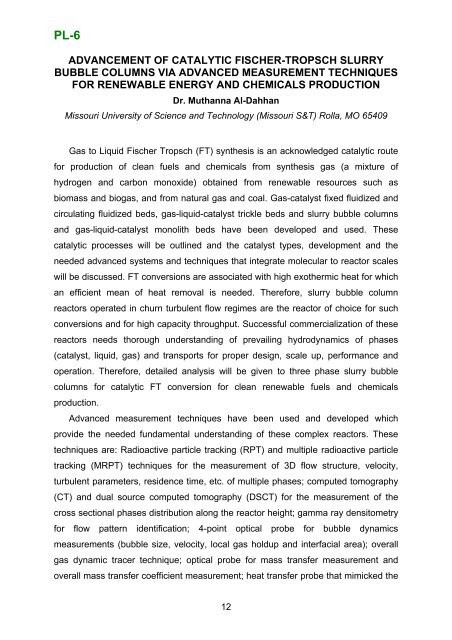Boreskov Institute of Catalysis SB RAS, Novosibirsk, Russia
Boreskov Institute of Catalysis SB RAS, Novosibirsk, Russia
Boreskov Institute of Catalysis SB RAS, Novosibirsk, Russia
- No tags were found...
Create successful ePaper yourself
Turn your PDF publications into a flip-book with our unique Google optimized e-Paper software.
PL-6ADVANCEMENT OF CATALYTIC FISCHER-TROPSCH SLURRYBUBBLE COLUMNS VIA ADVANCED MEASUREMENT TECHNIQUESFOR RENEWABLE ENERGY AND CHEMICALS PRODUCTIONDr. Muthanna Al-DahhanMissouri University <strong>of</strong> Science and Technology (Missouri S&T) Rolla, MO 65409Gas to Liquid Fischer Tropsch (FT) synthesis is an acknowledged catalytic routefor production <strong>of</strong> clean fuels and chemicals from synthesis gas (a mixture <strong>of</strong>hydrogen and carbon monoxide) obtained from renewable resources such asbiomass and biogas, and from natural gas and coal. Gas-catalyst fixed fluidized andcirculating fluidized beds, gas-liquid-catalyst trickle beds and slurry bubble columnsand gas-liquid-catalyst monolith beds have been developed and used. Thesecatalytic processes will be outlined and the catalyst types, development and theneeded advanced systems and techniques that integrate molecular to reactor scaleswill be discussed. FT conversions are associated with high exothermic heat for whichan efficient mean <strong>of</strong> heat removal is needed. Therefore, slurry bubble columnreactors operated in churn turbulent flow regimes are the reactor <strong>of</strong> choice for suchconversions and for high capacity throughput. Successful commercialization <strong>of</strong> thesereactors needs thorough understanding <strong>of</strong> prevailing hydrodynamics <strong>of</strong> phases(catalyst, liquid, gas) and transports for proper design, scale up, performance andoperation. Therefore, detailed analysis will be given to three phase slurry bubblecolumns for catalytic FT conversion for clean renewable fuels and chemicalsproduction.Advanced measurement techniques have been used and developed whichprovide the needed fundamental understanding <strong>of</strong> these complex reactors. Thesetechniques are: Radioactive particle tracking (RPT) and multiple radioactive particletracking (MRPT) techniques for the measurement <strong>of</strong> 3D flow structure, velocity,turbulent parameters, residence time, etc. <strong>of</strong> multiple phases; computed tomography(CT) and dual source computed tomography (DSCT) for the measurement <strong>of</strong> thecross sectional phases distribution along the reactor height; gamma ray densitometryfor flow pattern identification; 4-point optical probe for bubble dynamicsmeasurements (bubble size, velocity, local gas holdup and interfacial area); overallgas dynamic tracer technique; optical probe for mass transfer measurement andoverall mass transfer coefficient measurement; heat transfer probe that mimicked the12
















